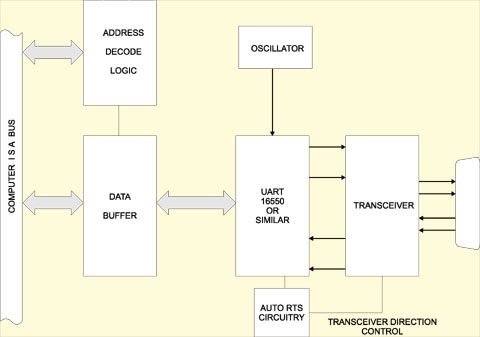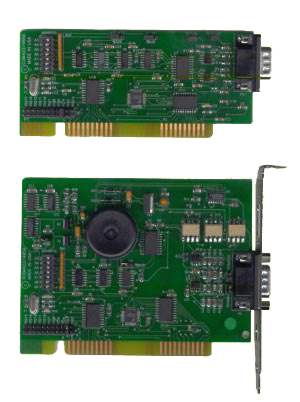COM422/485A and ICOM422/485A
Features
- Supports RS-422 and RS-485 asynchronous communication on the ISA bus
- Automatic control of RS-485 driver under Windows systems
- Includes type 16550 UARTs with 16-byte FIFO buffers
- Can be set up as COM1, 2, 3, 4, or any other I/O bus address
- Baud rates up to 460,800 baud
- Model ICOM422/485A provides opto-isolation
- Designed, made, supported, and manufactured in the USA
Price range: $130.00 through $192.00
In StockDescription
The COM422/485A and ICOM422/485A cards were designed for asynchronous transmission/reception over long data lines and can be used in either RS-422 or RS-485 mode. The only difference between the two models is that the communication lines on the ICOM422/485A are isolated. The card’s I/O bus address is selected by DIP switch and is not limited to AT-bus COM port addresses. Utility software included with these cards helps you select an address without fear of conflict with other installed resources.
A crystal oscillator located on the cards permits precise baud rate selection from 50 to 115,200 baud. Moreover, jumper selection provides capability for baud rates up to 460,800 baud.
Type 16550 buffered UART’s are used as the communication element. These include a 16-byte transmit/receive FIFO buffer to protect against lost data in multitasking operating systems while maintaining 100% compatibility with the original IBM serial port.
The transceivers used, type 75ALS180, are capable of driving extremely long communication lines at high baud rates. They can drive up to ±60 mA on balanced lines and receive inputs as low as 200 mV differential signal superimposed on common mode noise of +12V to -7V. In case of communication conflict, the transceivers feature thermal shutdown. Opto-isolators on the “ICOM” model provide 500-volt isolation.
Auto-RTS Transceiver Control
In RS-485 communications, the driver must be enabled when needed and then, when done transmitting, disabled to permit all cards on the network to share a two-wire or four-wire cable. The COM422/485A has two methods to control the drivers: automatic (AUTO) and request-to-send (RTS) control. Under automatic control, the driver is enabled (and the receiver disabled) when data are ready to be transmitted. When transmission is complete, the driver remains enabled for the transmission time of one additional character and then is disabled. The card automatically adjusts its timing to the baud rate of the data. The receiver is normally enabled but is disabled during transmissions and then re-enabled after transmission is completed. (Note: For operation in half-duplex under Windows, the card must be operated in the AUTO mode.)
If you wish to operate in the conventional request-to-send (RTS) mode, your application program must set a bit to enable the driver and reset that bit to disable the driver.
Modified-COTS (MCOTS) Customization
ACCES can tailor any standard product to your precise requirements — electrical, mechanical, firmware, environmental, or connector-level. Common MCOTS options include alternate I/O ranges, isolation enhancements, firmware changes, private labeling, conformal coating, extended temperature operation, ruggedized enclosures, and military-grade components. If this product is close but not a perfect fit, our engineering team can deliver a rapid-turn MCOTS variant with minimal NRE and dependable, Made-in-USA quality.
Downloads
Manuals
Software
- COM422/485A Software Package ( -- Last Uploaded 2025-05-07)
- ICOM422/485A Software Package ( -- Last Uploaded 2025-05-07)
Drivers and Downloads
Full list of available Downloads: Software Packages, Drivers, Manuals, and other documents
Information about our Free Software packages:
ACCES is proud to provide a full suite of software support with every Data Acquisition product. We are committed to supporting the most popular operating systems and platforms for our customers. Currently we are actively supporting 7 -> 11, both 32 & 64 bit, including “Server 2008,” “Embedded,” and “Compact” flavors for all plug-and-play products including PCI, PCI Express, USB, and more. Many products continue to ship with support for additional operating systems such as DOS, Windows 95, 98, Me, NT4, 2000, and XP.
Samples
Among the software we deliver with our products are sample programs in a wide variety of programming languages. These samples are used to demonstrate the software interfaces to our products — and many can be used as-is in your production environments, or to test functionality of the devices out-of-the-box. We’re currently actively supporting sample programs in Microsoft Visual C#, and Delphi, with many devices including samples in Visual Basic (5 and .NET), Visual C/C++, and Borland C/C++ 3.1 for DOS. Additionally we provide National Instruments LabVIEW compatible DLLs and many demonstration VIs for our devices.
Drivers
Drivers for various operating systems are also provided, including active support for Windows 7 -> 11 — all in both 32-bit and 64-bit flavors, and including consumer, server, and embedded varieties — as well as the 2.6 and newer Linux kernels and recent OSX / macOS versions. Many products continue to ship with driver support for Windows 95, 98, Me, NT4, Windows 2000, XP, and more, but support for these operating systems is considered deprecated.
Setup Programs and Utilities
Our Data Acquisition devices also include a graphical setup utility that walks you through the process of configuring any option jumpers or switches on the device, as well as explaining a little about the various connectors present.
Many devices also include utility programs – little tools to make your use of the device easier, such as EWriter, a program that allows you to read and write data in the user-accessible EEPROM locations on all our USB data acquisition products; or WinRISC, a “Really Incredibly Simple Communications” terminal program that lets you get started instantly with serial devices.
“Register Level” Documentation
Besides all this software in all these languages and operating systems ACCES has a policy of open and transparent development: none of our lowest-level “register” interfaces are hidden from you — we document every register in every bus card, every command in every serial board, and every usb control transfer in every USB Data Acquisition board. These lowest-level interfaces allow you to develop for our products in ANY operating system or language, regardless of our actively supporting it or having a driver for it. We have customers actively developing in ADA, Android, Python, Java, MATLAB, Solaris, and more, just by referring to our complete low-level interface documentation! And we provide the full source code to all of our drivers, regardless of operating system, to give you an even bigger head start in your own development tasks.
No Fees or Royalties
All of this software is provided at no additional charge, and is licensed under any of a variety of flexible — and royalty free — options. Check out our software license explanation if you’d like more information.
Custom Software
ACCES also offers Custom Software Services for our products. Our prices are unbelievably low, often as inexpensive as free! If you need something tweaked to support your needs, or an entire enterprise application developed from scratch, it is definitely worth your time to inquire with us, first.
Further information about available ACCES Software:
Redistributing Windows Drivers
A list of ACCES drivers and the files that compose them under different versions of Windows, so you can easily redistribute ACCES cards and drivers.

Model ICOM422/485A also includes opto-isolators between the UART and the Transceivers and a DC-DC converter to provide isolated 5VDC power.
Communications Interface
- Multimode: May be used in either RS-422 or RS-485 serial communications. Up to 32 drivers and receivers allowed on line. Serial communications UART used is type 16550 with 16-byte FIFO buffer. Transceiver used is type LS75176.
- I/O Connections: 25-pin, shielded, male sub-D connector
- Character Length: 5,6,7,or 8 bits
- Parity: Odd,even,or none
- Stop Interval: 1,1.5,or 2 bits
- Serial Data Rates: Up to 115,200 baud, asynchronous. A faster range of rates, up to 460,800 baud is achieved by jumper selection on the card.
- Common Mode Voltage Rejection: -7V to +12V
- Receiver Input Sensitivity: ±200 mV differential input minimum
- Transmitter Output Drive Capability: 60 mA, with thermal shutdown
- Isolation: ICOM422/485A includes isolation to 60V
- I/O Bus Address: Continuously mappable within 100 to 3 FF (hex) ranges of I/O channels.
Environmental
- Operating Temperature Range: 0° to 60°C.
- Storage Temperature Range: -50° to + 120°C.
- Humidity: 5% to 90%, non-condensing
- Power Required: +5 VDC at 400 mA typical
Size
- COM422/485: 5.025″ (128 mm) long.
- ICOM 422 /485: 7.25″ (184mm) long.
Regulatory Compliance
- This product is in full compliance with CE requirements.
| Model | Description | Price (USD) | |
|---|---|---|---|
| ICOM422/485A | ISA single port RS-422/485 card, Isolated | $192.00 | |
| COM422/485A | ISA single port RS-422/485 card | $130.00 |

